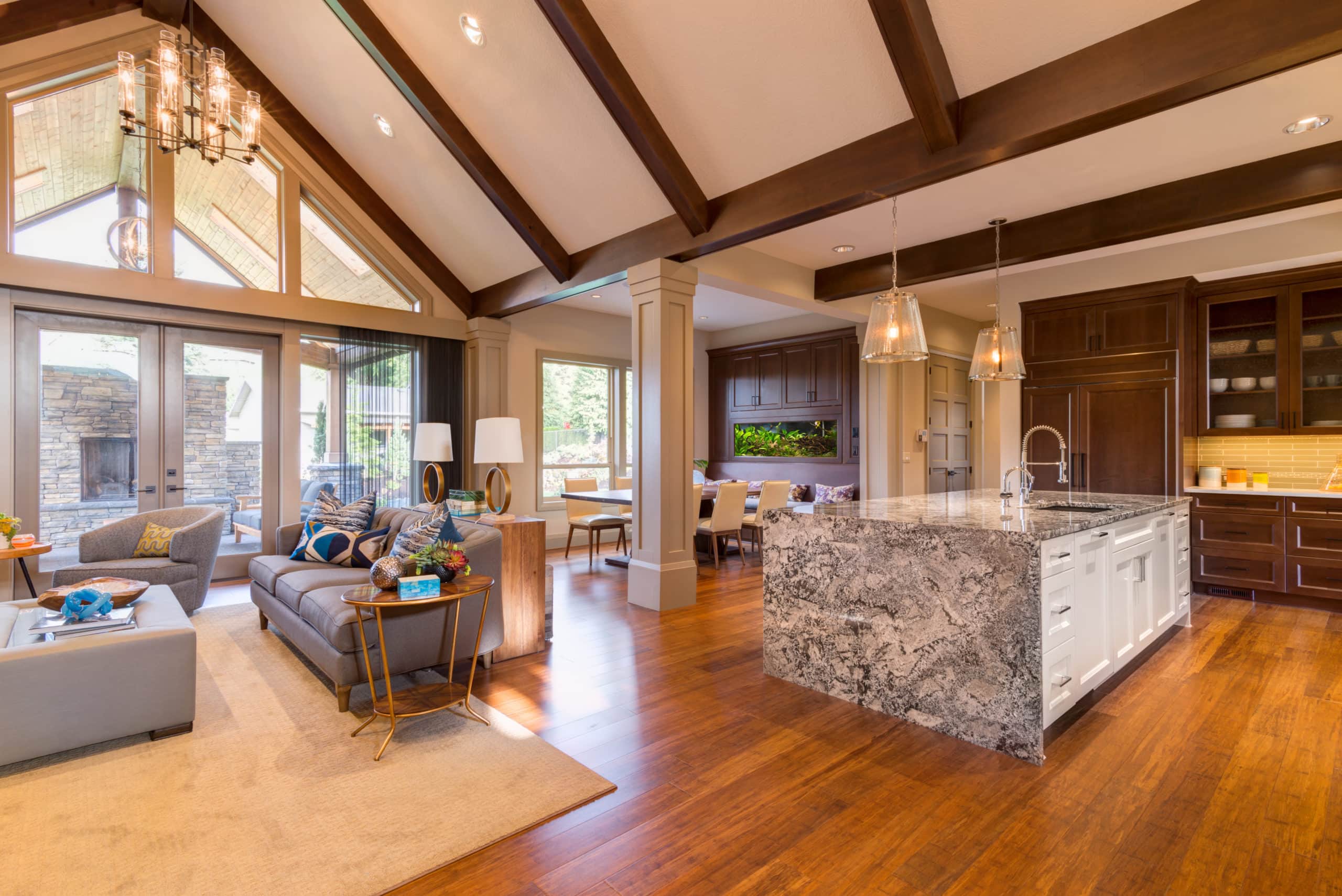Getting started on a whole home remodeling project can be intimidating. Where do you start, who can help, and what are the best improvements to make?
The single most important thing to remember is that you should always have a plan. When you go into your project well prepared, you’ll know exactly what you’re spending your money on and what you’re going to get out of it.
Before you even think about designs and material selections, make sure you’ve read this before-you-begin guide for whole home remodeling and renovation.
How to Start Planning a Whole Home Remodeling Project
While you might be tempted to start picking out paint colors, the start of the planning process is based on budgeting, finding how your renovation fits in your future plans, and selecting the right contractor for the job. There are plenty more questions you need to be asking yourself before you start, so let’s break them down.
Be Sure to Plan for the Future
Many homeowners make the mistake of remodeling only for the present, without thinking about the long-term future. If you’re likely to live in your current home for your lifetime, then you should aim to make an investment that continues to offer returns.
There’s a lot that you can do to future proof your home, from upgrading your plumbing, to installing underfloor heating. Each improvement should be chosen with longevity in mind. Spending a little more on materials today could ensure that they last a lifetime.
If you think that you will need more space in the future, then you could go beyond home renovation and include some moderate remodeling. Expanding your kitchen, converting a garage, or even finishing your basement could provide extra living space that will be useful as your family grows.
Remodeling is an investment, so make sure that it pays off.

Research Home Renovations that Will Bring Value
When you think of home remodeling as an investment, you’ll start to gain a better idea of the value that each improvement can bring. Even if you think you might move in the future, you could still aim for high quality renovations that will maintain or even raise the value of your home.
Some of the most valuable remodeling and renovation projects include:
- Garage door replacement: a new garage door could last for decades when properly maintained.
- Prominent exterior features like a stone veneer for your front siding.
- The addition of a deck or covered patio to increase your summer living and entertaining space.
- Kitchen remodeling or renovation. You can regain up to 80% of your costs at resale.
- Replacing your entry door will improve the curbside appeal of your home. Choose a high-quality designer steel door to improve looks and security.
- Replace your siding and roofing if your home is over 20 years old. This will protect the structure and raise appeal.
It’s especially important to focus on value-driven improvements when you only have a limited budget to work with.
Book Early, Especially During Peak Season
Let’s say you’ve planned your remodel, you know exactly what you want, and you’re ready to move ahead with a contractor. If you’ve proceeded with your plans and material ideas without talking to the professionals, then you could be disappointed when it comes time to book the work.
Contractors are especially busy during spring, summer, and autumn, which could leave you waiting to get your project started. Involve designers and home contractors as early as possible. This will give you an accurate timeframe for when work will begin, and when it’s likely to be completed. (Note that setbacks can occur. This is another reason why it’s important to book as early as possible during peak seasons).
There’s more than just convenience at stake here. Material prices can change throughout the year. You could even find that some of your preferred options are out of stock when you finally get around to booking the contractors.
Start as early as possible and avoid potential disappointment.
Separate DIY From Professional Work
Tens of thousands of homeowners take on DIY projects every year. Some of these are never finished, while others end up being completed with sub-par results. DIY is a great way to improve your home, but it’s not right for every project. Before you start any improvements on your own, ask yourself the most important questions:
- Do you have the time to take on a project while balancing work and family responsibilities?
- Do you have experience in DIY?
- Do you have the right tools to complete the work with professional results?
- Could the project be achieved quicker and with lower overall costs if you choose to work with a professional?
If you have doubts about any of these questions, then it’s likely that it would be better to work with a house remodeling contractor. Professional improvements typically come with less stress and disruption. Contractors also have access to wholesale prices on materials and hardware, so you could even save money while still paying labor costs.
Most importantly, professionals will leave your home looking its absolute best, with high quality craftsmanship that will stand up to daily use for years to come.

Make Sure Permits are Taken Care Of
Not every home renovation project requires a permit. Improvements that don’t change the structure, wiring, or plumbing of your home can typically be completed without a permit (although the rules can vary from state to state). Repainting, replacing flooring, and changing kitchen cabinets are all examples of renovation jobs that won’t need a permit. Basement finishing, plumbing upgrades, and major rewiring are examples of where permits would usually be required.
You should never begin remodeling without checking for compliance. You may also have rules enforced by a homeowner’s association. These typically govern the changes you can make outside of your home.
This is one area where professional house remodeling contractors can come in handy. A registered renovation company in Des Moines will ensure that all compliance issues are taken care of before the work begins.
Pack or Move Anything That Could Get in the Way
In the excitement that comes before whole home renovation, it’s easy to forget about the small things. For example; where will you store all your furniture and personal belongings while contractors are working?
Your garage could be an ideal place to move larger furniture items. If there’s a bedroom or secondary living area that won’t be remodeled, then this could also be an ideal location to move items that could get in the way. If there are things that can’t easily be moved, then these should be covered while work is ongoing.
Talk to your contractor about anything that might need to be relocated.
Choose a Space to Escape to During the Renovation
Have you ever heard of remodeling fever? It’s something that can develop in even the most level-headed homeowners. Remodeling fever is a feeling of chaos that can take over when the project begins. It’s natural to feel like you’ve lost control of your household when contractors are coming in daily. The noise and disruptions to your normal lifestyle can take a toll.
To combat this, you’ll need to set space aside where you can relax and escape the bustle of a large remodeling project. A bedroom, secondary living space, or even a detached guesthouse or finished garage could be suitable.
Another strategy is to plan remodeling and renovation work for times when you won’t be home. Some families even choose to have work performed while they’re on vacation. If you work with a project manager that you trust, then you can receive updates and make quick decisions even when you’re not at home. Email has changed the way we communicate, and it’s the perfect way to stay in touch during a home renovation. You could receive updates with pictures or even video, no matter where you are in the world.
Whether you’re going to be at home or anywhere else, setting a space to escape the chaos will ensure that you can beat remodeling fever.
Have a Clear Goal in Mind
Goal setting is just as important as planning. Unfortunately, the two are often confused. When you set goals for your remodeling project, they should be high level. Planning is different. It’s the time for details and should be performed along with a contractor or designer so that you can achieve your goals.
Some examples of goals for your project could include:
- Creating more space in your home. If your family is growing and you are running out of usable space, then a whole home remodel would be the solution.
- Modernizing your living spaces, bathrooms, kitchen etc. When you modernize your home, you bring it up to date while also adding features that will be useful in the future. Make this one of your goals and then build the details around it in the planning stage.
- Adding value to your home. If you plan to sell in the future, then you should aim to maximize the return that you get from your investment. Some carefully selected home improvements could increase the market value of your home. Even if improvements don’t add value, they could make your home more marketable, helping it to sell faster and cutting down your real estate fees.
- Adding accessibility for children or the elderly. The design of your home should be based around the age of those who live in it. If you have young children or you are planning to start a family, then you should create a home that is safe and convenient. Likewise, if you are soon to retire, or if you have elderly parents in the home, then your renovations should make the home safer and more accessible.
- Creating a Certain Look or Feel. Many homeowners have a goal of creating a particular style. You may want to create a transitional home, a period home that takes inspiration from history, or even a Mediterranean home that is light, bright, and airy. If you make a specific aesthetic one of your goals, you’ll be able to use examples to streamline the design stage.
It’s clear that goals aren’t quite the same as plans. Your goals will inspire and inform your whole home remodel. Present your goals to your designer and you’ll be able to nail all the details for a final blueprint.
Clean as You Go
This one might seem simple, but it’s something that many homeowners overlook. If you want to keep control of the project, then you should ensure that old materials and waste are being removed continuously throughout the remodel. If you work with experienced contractors, then this step will be relatively easy. Talk to the project manager about how they plan to manage waste and clutter for the duration of the remodel.
This is another one of those points where it becomes glaringly obvious that professional contractors are the best way to go. Waste and material removal is something you might not even think about on a DIY project, but it’s critical to your peace of mind and comfort.
Don’t forget that some materials can be recycled for other projects. If you are removing hardware, cabinets etc. that could be reused, then make sure you tell your contractor. Some of the items you remove today could be used for a future basement finishing, guesthouse, teen detached bedroom etc.

Look for the Best Home Remodeling Contractors in Des Moines
Even with all the best planning, you’ll need to make sure that you work with a team of contractors and designers that you can trust. Look for referrals from friends and family, or simply talk to local contractors to learn about their business and past projects.
In Des Moines, HomeWorx Iowa is your premium choice for remodeling and renovation that brings value and long-lasting beauty.
We offer complete project management, ensuring your home renovation goes as smoothly as possible. With 3D design at the consultation stage, you can fully visualize your improvements before signing off on a final concept. Our workmanship is second to none. We make homes that matter and that will stand the test of time.
Talk to us today to begin your next whole home remodeling or renovation project.



0 Comments